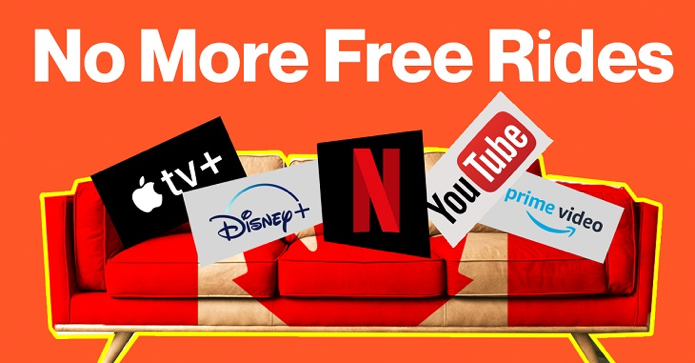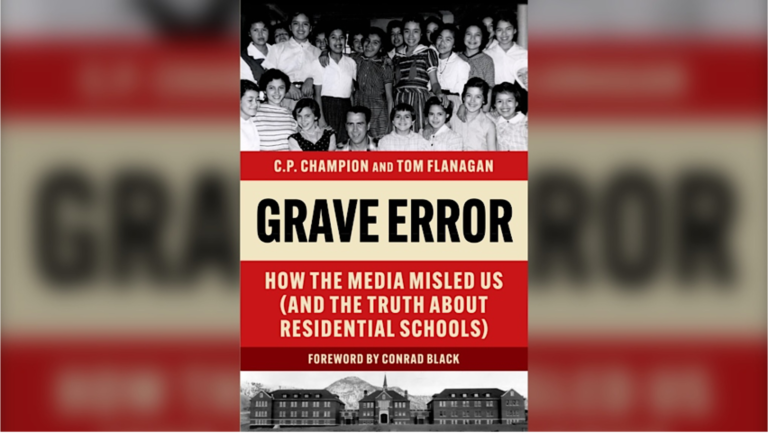As the final policy pledge of his Conservative leadership campaign, Pierre Poilievre vowed to introduce the Plain Language Act requiring federal laws to be written in clear, simple language and government publications to use “the fewest and simplest words possible.” Lawyers and bureaucrats would likely reply that complex language is needed to attain maximum specificity. But, Poilievre implied, one shouldn’t give governments the benefit of the doubt: they aren’t actually trying to be specific.
Such is the case with Bill C-11, the Liberal government’s Online Streaming Act, which has passed the House of Commons and is currently before the Senate. A complex set of amendments to the much older Broadcasting Act, the Online Streaming Act would classify all audio and visual “online undertakings” as a form of broadcasting that will come under the authority of Canada’s radio and television regulator, the CRTC. Huge international digital platforms like YouTube, Spotify and TikTok would have to hew to CRTC regulations, including a requirement to promote Canadian content, although exactly how is still not defined. Bill C-11’s stated intent is to create a level playing field for Canada’s filmmakers, YouTubers and other cultural creators who are supposedly being taken advantage of by big tech companies.

Despite this benign-sounding claim, everyone from technology trade groups to legal scholars, social media companies to their users has come to the same conclusion: C-11 is a bad and dangerous idea. By declaring every piece of user-generated audiovisual content – which would encompass the Instagram posts or YouTube videos of private individuals, even by children – a form of broadcasting subject to CRTC regulation, the state will gain the power to censor or remove that content.
Wrong, say the Liberals. They aren’t trying to regulate, much less censor the internet. The critics are all spreading misinformation. Somehow, the government has come to a radically different conclusion about what its own legislation says. Notably, among C-11’s few prominent supporters are Canada’s corporate and public media, who apparently would like to see the internet turned into a heavily regulated environment, like radio and television. In late June the bill passed its crucial Third Reading in the House of Commons by a vote of 208-117, with the NDP and Bloc Québécois supporting the Liberals and only the Conservatives voting against. Coverage by the legacy media was muted.
Read Our Lips, Not Our Legislation
Canada’s YouTubers, and YouTube itself, are adamant that this bill spells disaster for the free internet in which they have thrived. It’s far more than that, however. C-11 could create the most authoritarian regulatory framework of any democracy in the world. This makes it a grave threat to overall freedom of expression in Canada. Nearly as reprehensible as the implications of the legislation itself are the tangled thicket of unclear or self-contradictory language within the bill and the evident insincerity and misdirection in the government’s public promotion of C-11. In short, the Liberals are attempting a colossal power grab while pretending they aren’t.
Bill C-11 is littered with doublespeak and jargon that obfuscate its meaning. This begins in just the second subsection of the bill’s summary, which specifies “…(b) that the Act does not apply in respect of programs uploaded to an online undertaking that provides a social media service by a user of the service, unless the programs are prescribed by regulation…”

The Liberals point to statements such as this one to support their claim that they are not planning to regulate user-generated online content. This claim is belied, however, by the closing words of subsection (b): “unless the programs are prescribed by regulation.” Translation: the new act will not apply to user-generated content except for the cases when it does – which the government will determine on its own and cover in yet-to-be crafted regulations.
Section 2.1 of the bill does state that social media users will be excluded from regulation. While that sounds reassuring, this apparently solid protection is probably next to worthless. That is because there are two different constituent publishers of social media content: the user generating the content and the social media service which disseminates it. This means that even if social media users are technically exempt, per section 2.1, their content could still be regulated via the social media platform it sits on. Bill C-10, C-11’s progenitor which died when last fall’s election was called, included a provision in its section 4.1 specifically excluding the regulation of user-uploaded content and of social media services whose broadcasting consists only of user-generated programs. But after being lobbied by organizations like Friends, an advocacy group for the CBC, Bill C-11 was introduced devoid of the 4.1 exclusions.
If the government doesn’t intend to use its powers to regulate user-generated content, then why include them in the legislation – and then repeatedly deny that those powers exist?
Instead of writing a more coherent law or pulling the bill entirely, the Liberals decided to steamroll it through Parliament and pretend it doesn’t contain what it obviously does. “With Bill C-11, we’re asking the online streaming companies that benefit from Canadian culture to contribute to it. Canadians and their content are excluded. Period,” Heritage Minister Pablo Rodriguez declared in May.
The language and legal implications of the law itself, however, unquestionably trump a mere statement by a government minister. Rodriguez’s claim soon collapsed when CRTC chair Ian Scott was forced to admit his commission would have the power to regulate and censor user-generated content. “As constructed, there is a provision that would allow us to do it as required,” he told the House of Commons Heritage Committee that same month.

Finally hearing this admission was, in its own curious way, a relief to many of the bill’s critics. “It’s nice to see the truth is finally on the table, the bill captures everything. Once the CRTC has these powers, it’s real tough to undo legislation,” said Scott Benzie, the director of Digital First Canada, an advocacy group for online creators. Michael Geist, Canada Research Chair in Internet Law at the University of Ottawa, agreed: “Scott’s remarks confirm what was plainly obvious for anyone who took the time to read the bill.” Geist is probably the bill’s most prolific detractor, regularly updating the public through his blog. “The door is wide open for the CRTC to establish regulations on user content including discoverability rules that could harm Canada’s digital first creators,” he said. “There are good reasons no other country in the world regulates user content in this way.”

Liberal Intentions: More Real than Reality
The government has no convincing reply to these concerns. CRTC chair Ian Scott was left with asking Canadians to make a leap of faith: even though the bill would give his organization these powers, Canadians should simply believe that they’ll never be used. “There should be a higher degree of trust in relation to the commission’s future actions,” Scott pleaded. He insisted that in 50 years, the CRTC has “never interfered with individual content.”
A spokesperson for the CRTC took the same tack. “As it’s drafted at the moment, the bill draws a clear distinction between the users of social media and the platforms themselves,” they stated. “It’s clear to the CRTC that the bill’s intent is to exclude individual users from regulation.” But if that is truly the case, then why not drop the last phrase in subsection 2.1 and end with a full stop after stating that users are excluded? If the government doesn’t intend to use these powers, why include them in the legislation – and then repeatedly deny that those powers exist? Critics like Geist saw through the government’s flimsy rationalization.
It is ludicrous to insist that a claimed intent matters more than the law itself. What happens if the Liberals simply change their minds? Even if they are being honest and sincere, what happens when a new government with a different intent is elected?
Rather than be lulled by the Liberals’ soothing claims regarding their intentions, it seems more prudent to consider the worst-case scenario ... ultimately, the regulator could censor anything it pleased.
Scott’s contention that the CRTC has never interfered with “individual content” is another misdirection. That is because the Commission only had the power to regulate the content of individuals with access to a radio or television platform – i.e., who were broadcasting. And here it “interfered” whenever it pleased, using its broad statutory authority to ensure that “the programming originated by broadcasting undertakings are of high standard” – including as recently as last June. That’s when the CRTC stepped into a controversy involving the “N-word” in Quebec.
Radio Canada presenters had uttered the word when referring to a petition calling for a Concordia professor to be fired for himself uttering it while referring to an infamous Quebecois book written in 1968, N—s blancs d’Amérique. The CRTC demanded the network apologize, triggering vehement pushback in Quebec, including a demand from Premier François Legault that the CRTC itself apologize.
The CRTC’s track record of censorship makes it easy to imagine – indeed, to expect – a regulatory landscape in which it and/or the government would make similar rulings about social media content – which is now defined as a form of broadcasting (and to recap, the Online Streaming Act is a set of amendments to the Broadcasting Act). How might the CRTC, armed with its new powers, respond if someone posted a video in which someone uttered the N-word (or cited any other banned or disfavoured word, phrase, idea, lyric, poem or quotation) and they didn’t even hear it before posting? Would that make the person guilty of violating the Online Streaming Act?
Regulating the Right to Free Speech into a Government-Supervised Privilege
Rather than being lulled by the Liberals’ soothing claims regarding their intentions, it seems more prudent to consider the worst-case scenario in which the government uses the full force of the new powers it has given itself. In an interview with C2C Journal, former CRTC vice-chair Peter Menzies predicted a bleak future in which online speech is no longer a right but a privilege. “If you’re producing audiovisual content, you would have to be licensed and registered, and if you were non-compliant, the CRTC could order an internet service provider to block you,” said Menzies, who was also previously publisher of the Calgary Herald. The CRTC might then create a list of guidelines that Canadians must follow. Ultimately, however, the regulator could censor anything it pleased, not just taboo words.

As bad as Bill C-11 appears, it is not the Justin Trudeau government’s only effort to control and limit online speech. Last year it introduced a bill to combat harmful online content such as hate speech and support for terrorism. Bill C-36 died when the election was called – but not before coming under widespread and vehement attack. In April the aforementioned Geist used an Access to Information request to obtain the results of the government’s consultations with stakeholders. Feedback was overwhelmingly negative. The National Council of Canadian Muslims said the legislation “could inadvertently result in one of the most significant assaults on marginalized and racialized communities in years.” Privacy advocates, companies like Microsoft, Pinterest and TikTok, as well as legal experts like Geist also were deeply critical. Canada’s telecom giants (Telus, Rogers, Bell, Shaw, Cogeco and Quebecor) objected to disclosing subscriber information without judicial authorization and said the bill could harm investment in 5G infrastructure.
But the most damning submission came from Michele Austin, Twitter Canada’s head of public policy, who took particular aim at the bill’s proposal to create a Digital Safety Commissioner to block websites it found objectionable. “People around the world have been blocked from accessing Twitter and other services in a similar manner as the one proposed by Canada by multiple authoritarian governments (China, North Korea, and Iran for example) under the false guise of ‘online safety,’ impeding peoples’ rights to access information online,” she stated. There were no checks on the commissioner’s authority, she noted, and no requirements for judicial authorization or warnings to service providers. “If Canada wants to be seen as a champion of human rights, a leader in innovation and in net neutrality globally,” Austin wrote, “it must also set the highest standards of clarity, transparency and due process in its own legislation.”
Bill C-11’s discoverability provision means that content which Canada’s federal government deems unfit for public eyes will be buried by an algorithm that pushes its preferred content to the head of the line.
Instead of sincerely evaluating such well-considered and powerful objections, however, Heritage Minister Rodriguez is trying again on the online harms legislation, appointing a new expert advisory council presumably with the hope it provides a more supportive answer. The panel in summer recommended that the federal government begin regulating “propaganda, false advertising, and misleading political communications.” This despite experts warning that it could lead to censorship of journalism or online criticism of government. Early last month Rodriquez reiterated the government’s promise – or threat – to introduce a new version of the online harms bill sometime soon.
Manipulated Search Rankings: An Insidious Form of Censorship
C-11 isn’t as overtly censorious as the online harms proposal. It principally aims to promote content deemed acceptable by the government rather than punish the unacceptable. Its effects are still likely to be profoundly censorious, however. The key wording comes in C-11’s section 4.2, which deals with the issue of discoverability – what internet users see in search results. Section 4.2 will force social media platforms and streaming services to manipulate their algorithms so as to give preference to “Canadian” content at the expense of everything else.

“We would never tolerate the government setting rules specifying which books must be placed in front of our bookstores, but that’s exactly what the discoverability provision of C-11 is currently doing,” said Matt Hatfield, campaign director of advocacy group OpenMedia. “Manipulating our search results and feeds to feature content the government prefers instead of other content is gross paternalism that doesn’t belong in a democratic society.”
Nobody disputes that internet users overwhelmingly click on search results that appear on the opening page – usually high on that page. That is why millions of companies gladly pay to have search engines and social media platforms place their own “results” (i.e., ads) prominently on the opening page. Taking YouTube as an example, most people would rather click on a video that’s displayed on its homepage than dig through pages of search results to find something else – often, even when the original object of the user’s interest remains down there somewhere. YouTube’s recommendation algorithm powerfully influences what viewers “decide” to watch. Videos with a high engagement rate are more likely to end up recommended and will enter a positive feedback loop of more engagement. By contrast, a video that has been given a deliberate handicap – let’s say by a new government algorithm that finds it not “Canadian” enough – could end up grounded.
The story is similar across social media platforms, search engines and some websites. Bill C-11’s discoverability provision means that content which Canada’s federal government deems unfit for public eyes will be buried by the algorithm changes that push the preferred content to the head of the line. The other material might not be banished outright; it won’t need to be, because the results from manipulating search rankings will be nearly the same.
C-11 wasn’t made for the tens of thousands of Canadian content creators who have built successful businesses without government money. Some critics believe it was crafted largely to offer yet another crutch for legacy broadcasters who have been taking advantage of Canadian taxpayers and regulatory policy for decades.
So, what exactly qualifies as Canadian content and will be worthy of algorithmic blessing? We don’t get to know that yet – the government will create a definition once the bill is already law. As Geist points out, C-11 fails to address the myriad ways in which Canadian content could be defined. “The questions abound: is a Canadian YouTuber living in Los Angeles Canadian for discoverability purposes?” he asks. “Does a TikToker from France visiting Montreal qualify as Canadian content? Is a Twitch streamer in Vancouver that streams together with a gamer in Japan Canadian content? How about a podcaster that is based in Mexico but uses a Toronto production and hosting company?”

Some online creators have been warning that C-11 would hinder rather than help them. “Bill C-11 implies vague changes to these platforms to prioritize Canadian content to Canadians, but it would in turn deprioritize Canadian content to an international audience,” said Justin Tomchuk, a Canadian who runs two successful YouTube channels. He said C-11 could destroy them both, as 97 percent of his viewers are international. If YouTube was forced to push Tomchuk’s videos to the top of a Canadian’s feed and if Canadians, who are not his target audience, did not engage with his content, that would tell YouTube’s algorithm that his videos aren’t popular, meaning they wouldn’t be promoted internationally, where his audience is. The Canadian content prioritization provisions, said Morghan Fortier, who runs a YouTube channel with more than 34.2 million subscribers, were “written by people who don’t understand the industry.”
The government’s inability or refusal to define the discoverability provisions in the law itself should be reason enough for concern, Senator Paula Simons said recently in a speech to the chamber. While the government and CRTC insist the bill is only meant to capture big producers, “Unfortunately, that’s not what the bill actually says. It talks instead about people who are monetizing their content directly, or even indirectly. And that lack of clarity has led to justifiable confusion and concern that successful independent Canadian digital producers who use YouTube or Twitch or TikTok to reach global audiences could indeed be scoped in and captured and treated like Sony and Disney.”

The Alberta Senator, herself a former journalist, also took issue with CRTC chair Scott for doublespeak on the subject of government control. Scott had told a Senate committee that, “We want Canadians to find Canadian music. How best to do it? How will you do it? I don’t want to manipulate your algorithm, I want you to manipulate it, and produce a particular outcome.” Simons wasn’t having it. “So fine, the government won’t directly manipulate algorithms,” she noted. “But if the CRTC directs or compels companies such as YouTube to manipulate their algorithms to achieve the government’s desired outcome, well, that starts to become a distinction without a difference doesn’t it.”
Propping Up the Legacy Corporate Media: It Never Gets Old
However digital algorithms wind up being regulated to prioritize Canadian content, it is highly likely to benefit Canada’s legacy media outlets. C-11 wasn’t made for the tens of thousands of Canadian content creators who operate YouTube channels, podcasts and Instagram pages, who have built loyal followings and successful businesses without government money or government algorithms.
Some critics believe it was crafted largely to offer yet another crutch for legacy broadcasters (the CBC, CTV and Global) as well as print publications that increasingly use visual media to promote their core content, all of which have been taking advantage of Canadian taxpayers and regulatory policy for decades “I think what the government was probably trying to do with C-11 was make about 25 guys in Montreal happy,” Menzies told C2C, referring to the top executives of several legacy media outlets.

Marla Boltman, a representative for CBC advocacy group Friends, certainly sounded pleased in her opening statement at a Heritage Committee hearing into C-11. “With the adoption of Bill C-11, we as a country will finally send a long overdue notice to these foreign tech giants that their rent is due,” she declared. She seemed oblivious, or perhaps simply ignored, that in freely deciding to consume other content online, it is Canadians who are sending the CBC a notice.
Canada’s legacy media already have massive advantages thanks to name recognition, accepted legitimacy, prestige, various regulatory preferences and direct taxpayer subsidies. But even in these closed and privileged networks of television, radio and newspapers, where the dominant outlets face little to no direct competition, consumption has precipitously declined. Meanwhile, the consumption of content on the internet – the indirect competition – has been increasing for years across all age groups and has become the dominant medium for Canadians aged 14-24. “The broadcasting system needs to adapt to the internet, not the internet to the broadcasting act,” former CRTC commissioner Timothy Denton told the Senate committee examining the bill on September 14th.

Permission to Speak, Prime Minister?
Concerned stakeholders continue to push Senators to make amendments that would more clearly define and box in government powers. “Governments should be modest about imposing obligations on the technological future,” wrote the U.S.-based Consumer Technology Association of Arlington, Virginia (CTA) in a submission to the Senate committee on June 30. “Specifically, Canada should be cautious and precise about attempting to influence or define the information that is available to users.” The Liberals may end up accepting some amendments, but something closely resembling C-11 in its current form will very likely become law. If so, it will receive royal assent by year-end.

The government will then have to establish the scope of regulatory powers by sending a Cabinet order to the CRTC. “I fully expect that they will start off by saying this is only going to apply to companies with more than $100 million [in annual revenue],” says Menzies. “And there’ll be a big sigh of relief from a bunch of people like YouTubers.” But things could change over time. As John Lawford, executive director of the Public Interest Advocacy Centre, a consumer group, told the Senate committee: “It will take a number of years at the CRTC, but they may have regulations which get into things like what’s appropriate speech…whether there is some sort of political bent that is not in favour at that particular time. It’s possible.”
And then things will get messy. What happens if the government requires an individual practitioner to obtain a licence for their journalistic Instagram account, but they simply refuse and keep posting? What if the government orders a platform to do the dirty work of blocking or deplatforming the non-compliant individual and the platform refuses, or initiates a court challenge? As Canadians apprehend the worst-case scenario, an Orwellian hellworld where permission to speak online is only granted by the state, C-11 will surely be fought over in court – possibly in numerous loosely related but separate cases – as such heavy-handed suppression would be a blatant violation of Canadians’ Charter rights.
In the meantime, the yet-to-be built regulatory framework and the unknown key definitions of Canadian content will cause uncertainty in the digital marketplace probably stretching for years. “My big concern is that period of prosperity that you’ve seen with people investing privately in Canadian film and television is going to come to an end,” says Menzies. “People want to work in an environment where they know what the regulations are and that they will be enforced in a predictable fashion. But nobody will probably know what the regulatory landscape is for Canada until at least the end of the decade.”

Menzies thinks the government probably regrets having gone down its chosen route, because it finally realizes that Bill C-11 reveals a fundamental misunderstanding of what the internet is. “If you want more funding from web giants for your friends, just go get more money from web giants for your friends,” says Menzies, again referring to his belief regarding the Liberals’ underlying motives. “You don’t have to regulate the entire global internet.”
The Liberals might have saved themselves a lot of trouble had they simply listened to Canadians. A report by the Privy Council Office based on consultations with Canadians about the bill communicated a crystal-clear response: “The federal government should not be responsible for regulating content for Canadian audiences.” What kind of content people see should be decided by the consumer alone, the report said. But the legislation was never about what Canadians want. It amounts to a massive power grab by the government pushed by a cadre of cash-hungry conventional media executives and cheered on by a few advocates. No wonder selling C-11 truthfully – without lies or obfuscation – was never an option.
Fin DePencier is a Canadian freelance journalist based in Armenia reporting on regional conflicts and politics.
Source of main image: Shutterstock.






